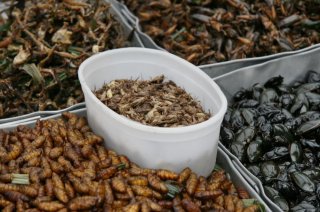
Project
Safe insect rearing on yet to be legally authorised residual streams
Underused organic residual flows are a source of valuable nutrients. This project focuses on conversion of these flows into safe, high-quality insect-based food and feed products. Scientifically sound procedures for this purpose will help legalization of safe use of residual streams for insect rearing.
Read the policy brief
The findings of the study are published in a policy letter 'Safe insect rearing on yet to be legalised residual streams’.
Circular agriculture in 2030
By 2030, the Netherlands wants to switch to circular agriculture, in order not to further deplete the soil, to preserve and improve biodiversity, to store carbon and nitrogen and at the same time to ensure a good and safe food supply. In order to achieve this, the Ministry of Agriculture, Nature and Food Quality has published a mission and realization plan for circular agriculture for 2030 (Realisatieplan Visie LNV, 2019). LNV agrees that insects are an underestimated new protein source and insects can easily grow on residual flows that are unsuitable for humans and animals. The LNV realization plan also mentions the known obstructing legislation and regulations and the ambition to remove these obstacles, especially in the field of the use of manure and waste, TSE regulations, the rules for keeping and feeding insects and the application of insect products. This project aims to contribute to the realization of this ambition, with a focus on the food and feed safety of insects.
Insect rearing
The essence of this project is to complete the necessary food safety data to enable the application of legally prohibited organic residual flows as a substrate for insect rearing. Underutilized residual flows such as food waste, slaughter by-products and animal manure are a source of nutrients. Insects can convert these into high-quality food products for animal and human consumption. This research focuses on the safety of various organic residual flows as a substrate for insect rearing and the safe application of these insects in food and feed. Moreover, the technical feasibility of the application is also taken into account. The aim of the project is to arrive at a procedure that is required for legal authorization of residual flows for insect rearing. This with the underlying goal of adding value to a wide range of organic residual flows in the food chain as much as possible by 2030.